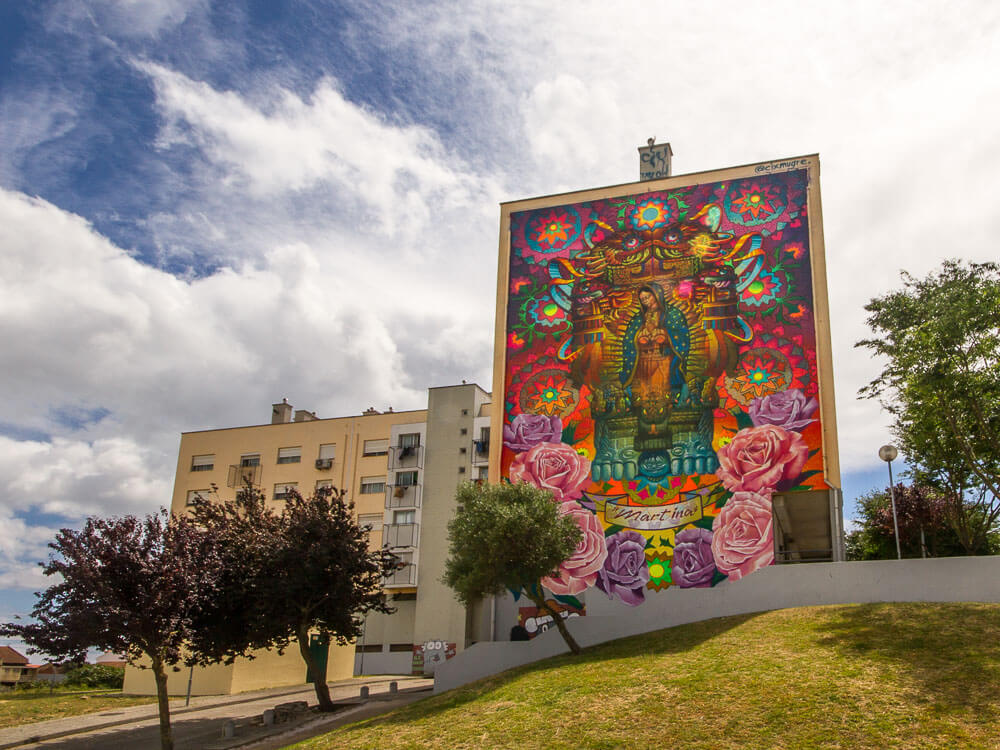Previously an industrial area on the eastern edge of Lisbon, Marvila is undergoing a cultural revival, breathing new life into its old warehouses and factories. Now, as you walk through the neighborhood, you’ll discover art galleries, restaurants, coworking spaces, and craft breweries.
It’s a place that offers genuine insight into Lisbon’s current culture while honoring its heritage, creating a fascinating blend of old and new. It’s also a hidden gem in the city, and not a lot of tourists have discovered Marvila.
But, since that is quickly changing, let’s stop wasting time and get into what really matters! In this guide, I’ll take you through its highlights, including art galleries, delicious restaurants, and locally brewed beer in historical buildings. Get ready for a complete guide of Lisbon’s most trendy neighborhood!

Index
1. Why visit Marvila?

Marvila was once a rough neighborhood on Lisbon’s outskirts, but has now transformed into a center for alternative lifestyles, innovative businesses and lots of craft beer (it’s actually known as the “beer district of Lisbon”). One could say it’s a very hipster neighborhood, and who am I to say otherwise?
But Marvila is more than that. It’s an area where you’ll find old industrial buildings repurposed into cultural venues and modern restaurants, as well as historic buildings with graffiti, art galleries, and an overall unique environment.
It’s precisely this new and contrasting side of Marvila that makes it such an attractive destination for people who want to experience an authentic and relatively unknown region of Lisbon.
With a riverside location that offers beautiful views and lots of green spaces, Marvila is a calm and safe area that almost makes you feel as if you’re in a different city, away from the busy tourist areas in downtown Lisbon.
2. How to get to Marvila?
Marvila is situated between downtown Lisbon and Parque das Nações, offering a balance of urban convenience and residential tranquility. Although there is no direct metro service there, it’s still easily accessible by bus, as there are several routes connecting Marvila to different parts of Lisbon.
One of them is bus 759, which starts at Restauradores Square in downtown and stops outside the Tiles Museum in Marvila. Alternatively, bus 728 covers many highlights, passing through historical sites like Belém and Praça do Comércio before heading to Santa Apolónia Station and continuing to Marvila, before eventually reaching Parque das Nações.
So, while the metro doesn’t directly serve Marvila, with Santa Apolónia being the nearest station about a 20-minute walk away, these bus services make visiting Marvila straightforward and convenient.
3. Where to stay in Marvila?
While Marvila may not be as tourist-centric as other areas in Lisbon, it still offers accommodation options for those seeking to explore a different side of the city. Here are my main recommendations:
- Duque de Conventus: located in Beato, close to Marvila, this facility offers amenities such as a restaurant, shared kitchen, luggage storage, and free WiFi. All rooms include essentials like air conditioning and desks, while some feature balconies with city views and private bathrooms.
- Mini Hostel in Lisbon: located 200 meters from Santa Apolonia metro station, this hostel features Middle East-inspired décor and offers accommodations in dormitories or private double rooms with heating systems and wardrobes. Additional facilities include a communal kitchen and an outdoor dining area with a lounge featuring a gazebo.
- Sant Jordi Hostels Lisbon: with a classical façade, an on-site bar and a private garden, this hostel offers 24/7 staff assistance, free WiFi and breakfast . Accommodation types range from private double rooms to mixed or gender-specific dormitories, with shared or private bathrooms depending on preference.
4. Best things to do in Marvila
4.1. National Tile Museum

The National Tile Museum is located in the 16th-century Convent of Madre de Deus in Marvila, Lisbon. The museum features a large and diverse collection of ceramic tiles (azulejos) from the 15th century to modern times.
The display shows how tile art has developed technically and stylistically over time, as well as its importance in Portugal’s history. There, you’ll also be able to explore a baroque church decorated with Dutch tile panels and paintings from the 16th and 17th centuries.
4.2. Fábrica Braço de Prata

Fábrica Braço de Prata is a former industrial factory that was transformed into an arts and culture center in 2007. Now, it attracts locals and tourists interested in the city’s cultural scene, offering facilities such as a bookstore, exhibition spaces, film screening rooms, and a live music stage.
The space also has a courtyard covered with graffiti and offers not only entertainment for adults, but also activities for children, including music and theater workshops.
It’s such an important place for Lisbon’s art scene that some celebrities are known for attending events. For example, Salvador Sobral, the 2017 Eurovision winner, has performed there, while Madonna also made some appearances over the years. How cool is that?!
4.3. Street Art

Ever since the MURO Urban Art Festival of 2017, Marvila has been known for its street art scene. That’s because the event brought together local and international artists to create large-scale graffiti and murals, transforming the neighborhood’s appearance as they breathed new life into historic buildings.
But the impact of these artworks goes beyond just aesthetics. The graffiti also had a significant role in rejuvenating Marvila, as well as fostering community pride, and attracting international visitors.
Though Marvila still deals with socio-economic challenges, the repurposing of neglected walls into street art was essential to solidify a community identity and enhance the area’s tourist appeal.
It’s one of the things that make Marvila such a unique neighborhood, and I think it’s truly amazing to be able to witness the impact that art can have in people’s lives!
4.4. Art galleries
Galeria Underdogs
Galeria Underdogs functions as both an art gallery and a cultural platform. It was established to support contemporary art and has a large exhibition space for Portuguese and international artists.
Focused on experimentation, the gallery challenges traditional boundaries and promotes new perspectives in the arts. It also engages with the community through outdoor programs, including street art tours and public art initiatives to improve Marvila’s urban landscape and cultural engagement.
Galeria Underdogs is a significant presence in Lisbon’s cultural scene, as it emphasizes accessible yet innovative artistic expressions, while supporting both emerging and established artists.
Galeria Filomena Soares
Galeria Filomena Soares, established in 1999, is a well-known gallery in Portugal’s contemporary art scene. It not only promotes artistic production, but also showcases modern artworks by both emerging and established Portuguese and international artists.
Renowned for its quality exhibitions that cover various mediums and styles, the gallery showcases the diversity of current artistic expression, attracting art enthusiasts worldwide.
Beyond its exhibition space, Galeria Filomena Soares hosts artistic events and participates in international art fairs. With its consistent support for artists, it’s a place that greatly contributed to Marvila’s emergence as a leading arts center in Lisbon, and definitely worth getting to know!
Tardoz
Tardoz is a workshop dedicated to restoring traditional Portuguese tiles, some of which are five hundred years old. Managed by Isabel Colher, her aim is to preserve this aspect of Portuguese heritage and teach tile conservation methods.
Visitors can schedule appointments to observe the tile restoration process and the detailed work involved in maintaining these historical pieces.
Through workshops and community activities, Tardoz actively works to keep this traditional craft alive for future generations, fostering cultural appreciation and encouraging broader community involvement.
Get inspired by Marvila’s artistic atmosphere

Marvila is still often overlooked in traditional travel guides, but it’s quickly becoming a popular destination for those who want to explore a different side of Lisbon, one that combines urban and contemporary art, culture, food and nightlife.
It’s a place that manages to remain authentic even with the major changes it’s seen in the past years. For one, I absolutely love the way the historical buildings were transformed and revitalized while keeping their original character instead of being torn down.
So, whether you’re into art, food, or simply want to experience a different side of the city, I think it’s definitely worth visiting Marvila and exploring its hidden gems before the secret is out!







